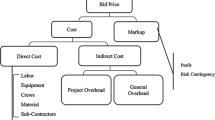Abstract
Civil engineering projects include several uncertainties and risks, due to the special characteristics of construction industry. Time and cost are two parameters that could potentially lead to successful and conforming to regulations production of projects. It is imperative to estimate correctly the development and the final outcome of these parameters. Various tools have been applied in order to create more accurate estimations. In this paper, a prototype system will be presented, which aims at predicting the final cost, based on information available at the bidding stage. The methodology will be based on a combination of regression analysis and case-based reasoning in order to produce models for the prediction of final cost. These models will incorporate a process view and will depend on activity based costing methodology to estimate the process cost.
Similar content being viewed by others
References
Angelides, D.C. (1999). “Project Management and Good Technical and Business Practices”. Journal of Management in Engineering, ASCE, Vol. 15, No. 3, pp 78–88.
Angelides, D.C. and Kirkinezou, M.K. (2001). ISO 9000 in Technical Companies, 1st edition, University Studio Press, Thessaloniki (in Greek).
Aouad, G., Cooper, R., Kagioglou, M., and Sexton, M. (1999). “The development of a process map for the construction sector”, Proceedings of Working Groups W65/W55, South Africa.
Aris Toolset, http://www.ids-scheer.com/english. (2004)
Brahalis, J. (2003). “Underestimation in Public Projects, Truth or Lie”, Greek Technical Chamber Journal, Volume 2259, http.//www.tee.gr/online/epikaira /2003/2259/pg027.shtml, 2003 (in Greek).
Cooper, R., Kagioglou, M., Aouad, G., Hinks, J., Sexton, M. and Sheath, D.(1998). “The development of a generic design and construction process protocol”, Proceedings of the European Conference on Product Data Technology Days, BRE, UK.
Cooper, R., Aouad, G., Lee, A., Wu, S., Fleming, A., Kagioglou, M. (2005). “Process management in design and construction”, Blackwell Publishing Ltd.
Edward M. J. (1996). “The impact of activity-based costing on project bidding”, PhD thesis, West Virginia University.
Eyers K. (2001). “Belief Network Analysis of Direct Cost Risk in Building Construction”, M.S. thesis, Department of Civil Engineering, University of Toronto, Canada.
Ghulman, B. A. (2000). “Predicting construction cost growth in ODOT’s paving projects using information available at the bidding time”, Ph.D. thesis, Oklahoma State University, USA.
Hegazy, T. M. (1993). “Integrated bid preparation with emphases on risk assessment using neural Networks”, Ph.D. thesis, Concordia University, Canada.
Hegazy, T. M. (2002). “Computer —Based Construction Project Management”, Pearson Education, Inc., Upper Saddle River, New Jersey 07458, Prentice Hall.
Kagioglou, M., Cooper, R., and Aouad, G. (1999). “Re-engineering the UK Construction Industry: The Process Protocol”. Proceedings of the 2nd International Conference on Construction Process Re-Engineering,CPR99, New South Wales University, Australia.
Kim Y. W., and Ballard, G. (2001). “Activity —Based Costing and its application to Lean Construction”, Proceedings of the 9th annual conference of the International Group for Lean Construction, National University of Singapore, Singapore.
Kim, G.H., An, S.H., and Kang, K.I. (2004). “Comparison of construction cost estimating Models based on regression analysis, neural networks, and case-based reasoning”. Journal of Building and Environment, Vol. 39, pp. 1235–1242.
Odeck, J.(2004). “Cost overruns in road construction —what are their sizes and determinants”, Journal of Transport Policy, Vol 11, pp. 43–53.
Ruozi, D., Rizzi, K., Ramelli, A., (2001). “Re-engineering of Product Development Process using ARIS”, Proceedings of the XII ADM International Conference-Grand Hotel-Rimini-Italy.
Skitmore, R. M. and Ng, T.S.T. (2003). “Forecast models for actual construction time and cost”. Journal of Building and Environment, Vol. 38, N. 8, pp. 1075–1083.
Westney, R., E. (1997). The Engineer’s Cost Handbook. Tools for managing Project Costs, 2nd edition, Marcel Decker, INC, 270 Madison Avenue, New York, New York 10016.
Williams, P. T. (2003). “Predicting final cost for competitively bid construction projects using regression models”. International Journal of Project Management, Vol. 21, pp. 593–599.
Yu, K., Froese, T., Grobler, F., (1999). “A development framework for data models for computer —integrated facilities management”. Journal of Automation in construction, special issue on facilities management.
Author information
Authors and Affiliations
Rights and permissions
About this article
Cite this article
Aretoulis, G.N., Angelides, D.C., Kalfakakou, G.P. et al. A prototype system for the prediction of final cost in construction projects. Oper Res Int J 6, 323–332 (2006). https://doi.org/10.1007/BF02941260
Issue Date:
DOI: https://doi.org/10.1007/BF02941260




